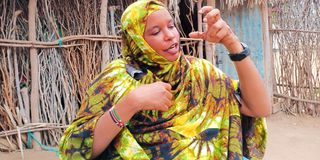‘It is like slaughtering a cow’, victim speaks of FGM misery

Anti-FGM activist Nastehe Aftin during a past interview with Nation.Africa in Kasarani Village, Tana River.
What you need to know:
- At 11 years, Jibril Hussein was circumcised alongside others in Gafuru village.
- She was pinned down by seven women as they held down each of her limbs during the traumatising event.
- Dayaa Women Group, have teamed up with FGM victims to protect young girls from the cut and counsel traumatised colleagues.
The mention of female genital mutilation (FGM) to a young victim in fouls the mood of the conversation immediately.
The tradition, which was the pride of every woman, has become highly despised among the youth.
“It is like slaughtering a cow. What was done to me has caused me trauma that I cannot allow my child to go through,” says Jibril Hussein.
At 11 years, Ms Hussein was circumcised alongside others in Gafuru village.
She notes that those scheduled for the cut wake up at 4am and walk for more than 15km from the village into the bush. The cut is done very far from the village where the screams of victims cannot be heard.
“I was pinned down by seven women as they held down each of my limbs,” she recounts.
The women stripped off her clothes while one sat on her chest, rendering her motionless as the cut was performed. No anaesthesia was used.
“I lost strength and fainted. When I woke up, my feet were tightly tied together with a cloth. I was among six others and we were all crying due to the pain,” she says. They were then made to walk back home with their feet tied together.
The ill-treatment, she says, continues through the recovery process. She says that one is fed only on tea for two weeks as solid food is discouraged.
Stitches
“A long call can interfere with the stitches, and when that happens, the circumciser is called to fix it, which means starting the procedure afresh,” she says.
For treatment, the girls are made to sit over a hole filled with burning charcoal and donkey dung “to dry up the wound”.
The anguish extends into marriage.
According to anti-FGM activist Nastehe Aftin of the Dayaa Women Group, when a man is unable to have his way, he calls the circumciser who performed the cut to “create a way”.
“There is no regard for the pain the woman goes through, it is always the man’s way. If the circumciser is not around, the man uses his dagger,” she says.
Ms Aftin notes that the pain has caused others to abandon their marriages while some choose not to get married.
“As Dayaa Women Group, we decided to team up with all victims and protect our children from the cut and counsel our colleagues who are traumatised,” she notes.
2030
However, their efforts suffer from lack of funds.
“I don't see us ending FGM by 2030 as we hoped unless the funding is truthful and objective ... people may go back to full-scale practice,” she says.
County Gender Officer Aggrey Nyangweso, says there are 200 traditional circumcisers so far identified for rehabilitation.
The department has also opened a GBV centre where victims are offered free psycho-social counselling at the Hola Referral Hospital.





